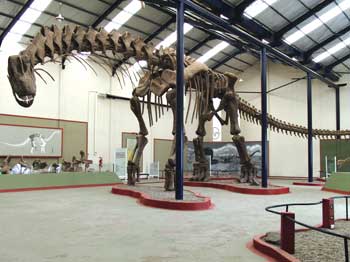It’s not exactly Jurassic Park, but it’s still pretty cool: Laser scans and computer modeling are now giving the human race a chance to watch one of the biggest dinosaurs in action. The digital reconstruction has enabled the gigantic Argentinosaurus to take its first steps in more than 94 million years.
The dinosaur in question now resides, so to speak, at Carmen Funes Museum in Plaza Huincul, Argentina. A team from The University of Manchester in England, working with scientists in Argentina, laser-scanned the dinosaur’s 40-m-long skeleton and used advanced computer modeling to re-create the beast’s walking and running movements.
“The important thing is that these animals are not like any animal alive today, and so we can’t just copy a modern animal,” said lead researcher Dr. Bill Sellers of the university’s Faculty of Life Sciences. “Our machine-learning system works purely from the information we have on the dinosaur and predicts the best possible movement patterns.”

Photo courtesy of Dr. Bill Sellers, University of Manchester.
Scientists previously thought that the 80-ton dinosaur was too big to walk, but the first “virtual” dinosaur trackway provided by this study shows that it would have reached just over 2 m/s (about 5 mph), according to the new simulation, which used Sellers’ Gaitsym software.
The work was published in PLOS ONE (doi:10.1371/journal.pone.0078733). The team now plans to re-create the gaits of other dinosaurs, including Triceratops, Brachiosaurus and Tyrannosaurus rex.
That’s exciting for kids of all ages, but the research is more than about what’s nifty: “This is science, not just animation,” said the university’s Dr. Phil Manning. The team also included the university’s Dr. Lee Margetts as well as Dr. Rodolfo Coria from the museum, who was behind the first Argentinosaurus physical reconstruction.
The research could be useful not only for musculoskeletal studies, but also for advances in robotics, Sellers pointed out. “All vertebrates, from humans to fish, share the same basic muscles, bones and joints. To understand how these function, we can compare how they are used in different animals, and the most interesting are often those at extremes. Argentinosaurus is the biggest animal that ever walked on the surface of the earth, and understanding how it did this will tell us a lot about the maximum performance of the vertebrate musculoskeletal system. We need to know more about this to help understand how it functions in ourselves.
“Similarly, if we want to build better-legged robots, then we need to know more about the mechanics of legs in a whole range of animals – and nothing has bigger, more powerful legs than Argentinosaurus.”